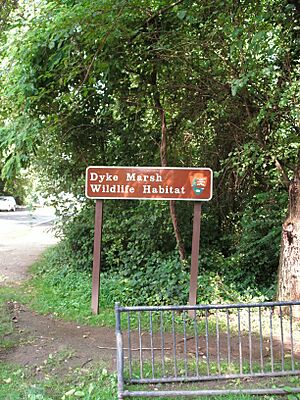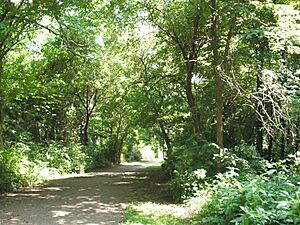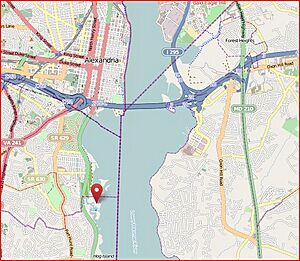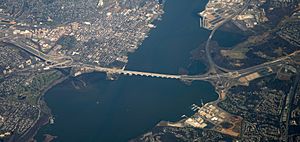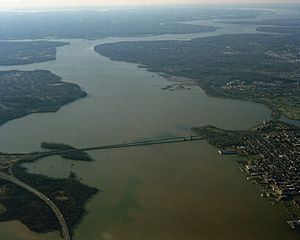Dyke Marsh facts for kids
Dyke Marsh is a special place on the Potomac River in Virginia. It's a wetland, which is like a watery area where land and water meet. This amazing spot is a wildlife preserve located near Alexandria and Mount Vernon.
Dyke Marsh covers about 485 acres. It includes a tidal marsh (land that gets covered by water from tides), a floodplain (flat land near a river that can flood), and a swamp forest. This marsh formed a very long time ago, between 5,000 and 7,000 years ago! It's one of the biggest freshwater tidal wetlands left in the Baltimore-Washington Metropolitan Area. The National Park Service takes care of Dyke Marsh as part of the George Washington Memorial Parkway.
This marsh is home to many different plants and animals. There's a path called "Haul Road" that lets visitors explore the marsh. It's a popular spot for people who love to watch birds. Dyke Marsh is easy to find, just off the George Washington Memorial Parkway at the Belle Haven Marina exit. Here, the fresh water from the upper Potomac River mixes with the saltier water from the lower Potomac. The fresh water usually floats on top of the salt water, creating this unique freshwater tidal marsh.
Contents
What's in a Name?
How Dyke Marsh Got Its Name
Dyke Marsh got its name because it used to have earthen walls around it. These walls, called "dikes," were built in the 1800s. People built them to create more "fast land," which means land that wasn't covered by tides. This land was then used for farming, like letting animals graze or growing crops.
One of the oldest pictures of Dyke Marsh is from around 1909. It was a postcard for the Alexandria-Mt. Vernon trolley line. The picture was labeled: The "Dyke," a favorite resort for fishermen and hunters on the line of the Mt. Vernon Railroad, near Alexandria, Va.
Amazing Wildlife in Dyke Marsh
Animals You Might See
Dyke Marsh is full of amazing wildlife! You can often see signs of beavers along the "Haul Road." Muskrats have also been spotted many times. If you visit at night, you might even see Little brown bats and red foxes. During the day, look for Cottontail rabbits, gray squirrels, shrews, and small field mice called voles.
Birds of the Marsh
The most common bird you'll notice in Dyke Marsh is the red-winged blackbird. You'll hear its special call and see it nesting among the cattails. These birds eat insects and seeds. Nearly 300 different kinds of birds have been seen in Dyke Marsh! This makes it one of the best places for birdwatching in the Washington Metropolitan Area. The lower Potomac River is a natural path for migrating birds, especially water birds. In 2014, a new type of beetle for Virginia, called Pterostichus sculptus, was found here too.
Plants of Dyke Marsh
Diverse Plant Life
More than 360 different kinds of plants grow in Dyke Marsh. The most common plant is the narrow-leafed cattail. It usually grows its special flower spike by June. Many other plants live here too, like several types of Sagittaria, arrow arum, pickerelweed, sweetflag, spatter-pond lily, and northern wild rice. The wild rice is important because it attracts animals like the red-winged blackbird and waterfowl.
How Dyke Marsh Has Changed
Past and Present
Dyke Marsh looks very different today than it used to. It's believed that the marsh was once much larger, covering about 650 acres. In the 1950s and 1960s, dredging took place. This is when machines remove mud and sand from the bottom of a river or marsh. This dredging made the marsh smaller and changed its shape. You can still see the effects of this dredging today, as the shoreline along the Haul Road is experiencing erosion (wearing away).
Non-Native Plants
People have also accidentally brought in some "exotic" or non-native plants to the marsh. These plants are very strong and often grow faster than the native plants that belong there. This can cause problems for the original plants. For example, exotic vines like Asian porcelain berry, Japanese honeysuckle, and Asiatic bittersweet are now covering parts of the floodplain forest. Yellow iris and the common reed are also exotic plants that live in the marsh. People are working hard to stop other non-native plants, like the purple loosestrife, from coming into the marsh.
Visiting Dyke Marsh
What to Do and See
Dyke Marsh is located right next to the George Washington Memorial Parkway and the Mount Vernon Trail. Thousands of people, including bicyclists, walkers, and runners, use the Mount Vernon Trail every week. Just off the trail, there's a nice sitting area on a boardwalk that goes over the marsh.
The main path inside the marsh is shaped like a "J." It goes south from the marina entrance and then turns east onto a peninsula. People who love birds, animals, and nature often visit this sitting area. They hope to catch a glimpse of all the amazing things Dyke Marsh has to offer. Some visitors even come at night to watch the fireflies glow in the marsh and trees.


